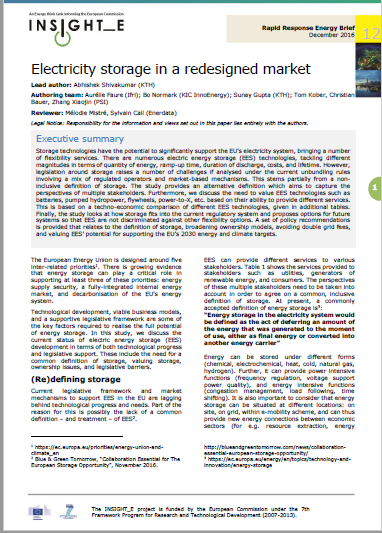Electricity storage in a redesigned market

Storage technologies have the potential to significantly support the EU’s electricity system, bringing a number of flexibility services. There are numerous electric energy storage (EES) technologies, tackling different magnitudes in terms of quantity of energy, ramp-up time, duration of discharge, costs, and lifetime.

However, legislation around storage raises a number of challenges if analysed under the current unbundling rules involving a mix of regulated operators and market-based mechanisms. This stems partially from a non-inclusive definition of storage. The study provides an alternative definition which aims to capture the perspectives of multiple stakeholders. Furthermore, we discuss the need to value EES technologies such as batteries, pumped hydropower, flywheels, power-to-X, etc. based on their ability to provide different services. This is based on a techno-economic comparison of different EES technologies, given in additional tables. Finally, the study looks at how storage fits into the current regulatory system and proposes options for future systems so that EES are not discriminated against other flexibility options. A set of policy recommendations is provided that relates to the definition of storage, broadening ownership models, avoiding double grid fees, and valuing EES’ potential for supporting the EU’s 2030 energy and climate targets.

Available in:
Regions and themes
Share
Download the full analysis
This page contains only a summary of our work. If you would like to have access to all the information from our research on the subject, you can download the full version in PDF format.
Electricity storage in a redesigned market
Related centers and programs
Discover our other research centers and programsFind out more
Discover all our analysesAI, Data Centers and Energy Demand: Reassessing and Exploring the Trends
The information and communication technologies sector today accounts for 9% of global electricity consumption, data centers for 1-1.3%, and artificial intelligence (AI) for less than 0.2%. The growing energy demands of cloud services first, and now AI workloads (10% of today’s data centers electricity demand), have exacerbated this trend. In the future, hyperscale data centers will gain shares amongst all kinds of data centers and AI will probably account for around 20% of data centers electricity demand by 2030.
Unlocking India’s Energy Transition: Addressing Grid Flexibility Challenges and Solutions
India is rapidly scaling up its renewable energy (RE) capacity, adding 15–20 GW annually, but the ambitious goal of 500 GW of non-fossil capacity by 2030 is at risk unless the pace accelerates.
Europe’s Black Mass Evasion: From Black Box to Strategic Recycling
EV batteries recycling is a building block for boosting the European Union (EU)’s strategic autonomy in the field of critical raw minerals (CRM) value chains. Yet, recent evolutions in the European EV value chain, marked by cancellations or postponements of projects, are raising the alarm on the prospects of the battery recycling industry in Europe.

The New Geopolitics of Energy
Following the dramatic floods in Valencia, and as COP29 opens in Baku, climate change is forcing us to closely reexamine the pace—and the stumbling blocks—of the energy transition.







